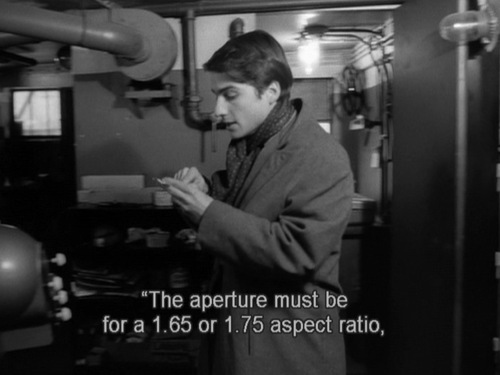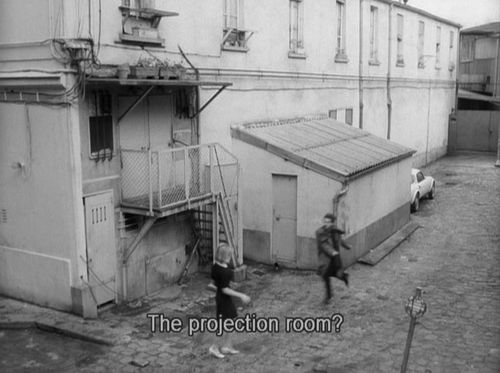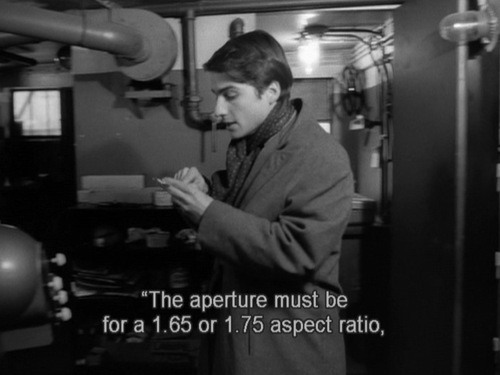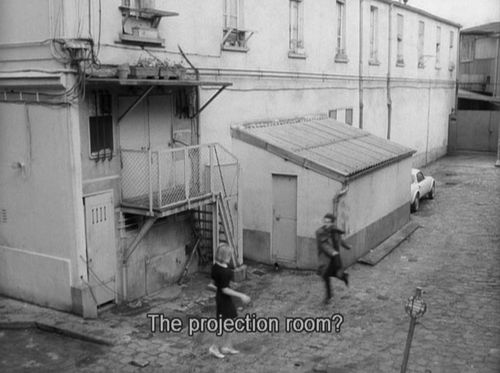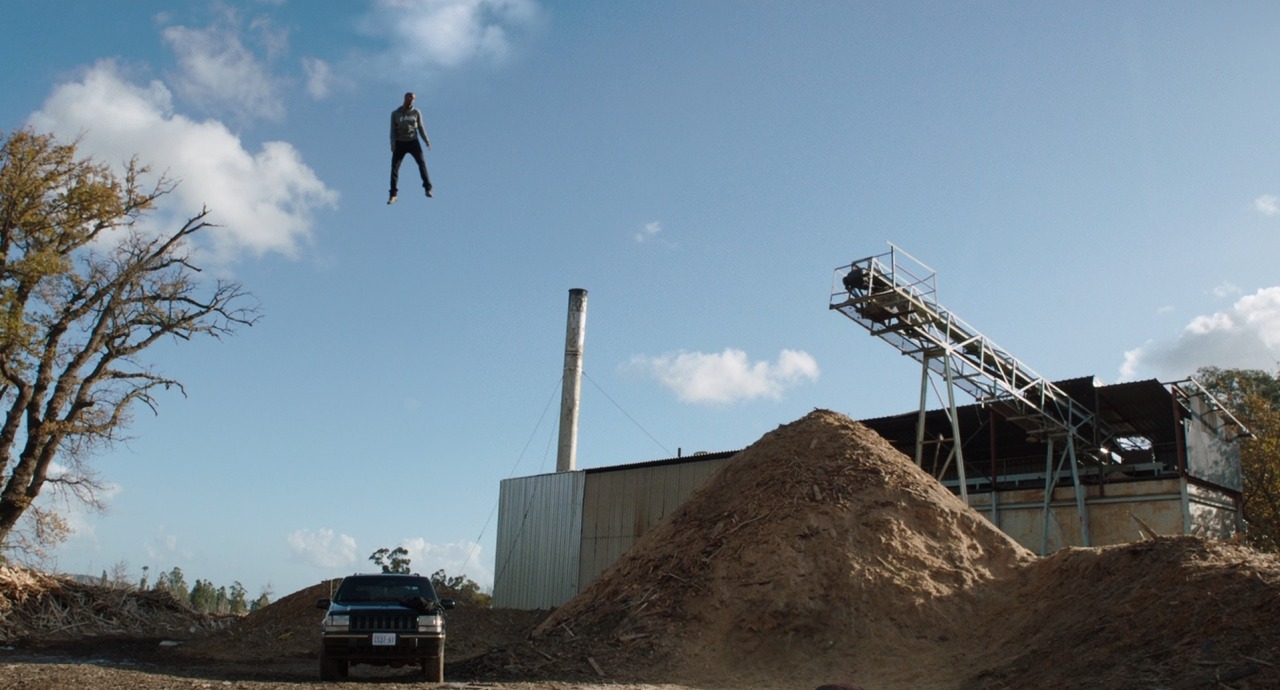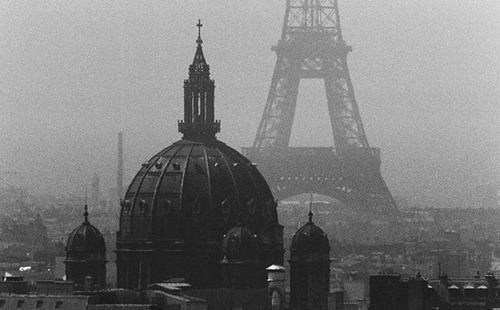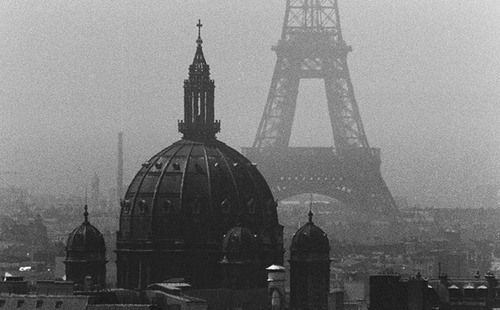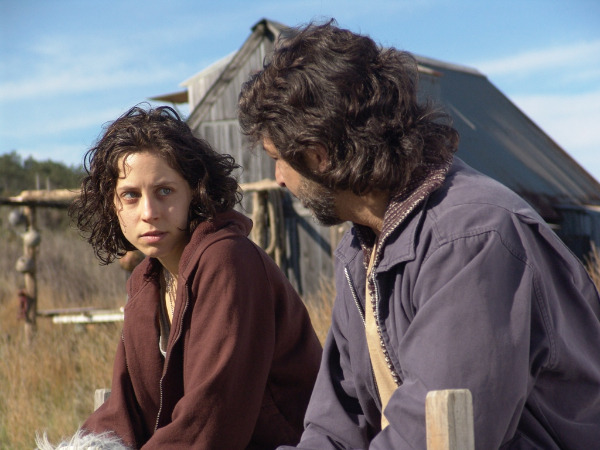The Punk Singer
I saw this at DocNYC tonight. The first Julie Ruin record and Real Fiction by The Fakes are two of my all time favourites, and I used to listen to a lot of riot-grrl. But the film, quite apart from being about someone I find interesting, was really good. The structure was sensibly organised around the bands Hanna was in. It put the music she made in an accurate, meaningful social context.
#notebook
The Punk Singer
I saw this at DocNYC tonight. The first Julie Ruin record and Real Fiction by The Fakes are two of my all time favourites, and I used to listen to a lot of riot-grrl. But the film, quite apart from being about someone I find interesting, was really good. The structure was sensibly organised around the bands Hanna was in. It put the music she made in an accurate, meaningful social context.
#notebook
Tommy Makem, The Butcher Boy
Tommy Makem, The Butcher Boy
Beyond the Hills
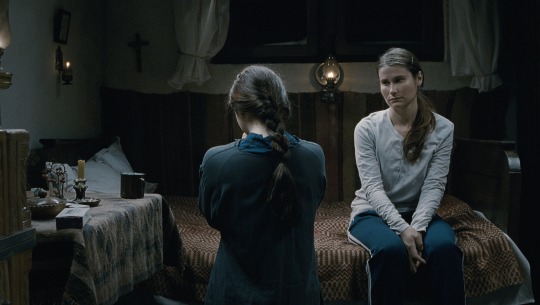
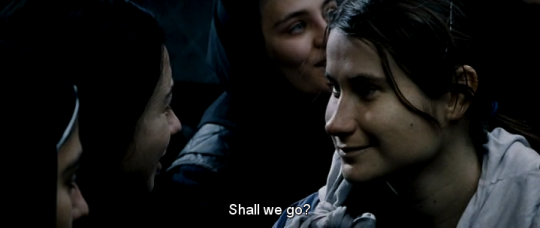
Spoilers.
I saw this six months ago when it came out at the cinema. It is almost as spare as Cristian Mungiu’s first film, 4 Months, 3 Weeks and 2 Days. But the film-making draws even less attention to itself. 4 Months… was sometimes so naturalistic that it was a little showy: the long supper scene with the static camera, the scene where the camera waits in the bathroom while each of the women go out to the bedroom to have sex with the man who performs the abortion.
Beyond the Hills is wonderful because the central relationship between the two women (second from left and on the right) is a complete mystery. What were they to each other before they were reunited at the convent? Why does the devout woman quietly and tenderly absorb the other’s affection and neither reject her nor let her in? Why does she finally decide to cast her lot in with her friend and leave the convent?
In the still above, the devout nun finally casts in her lot with her friend and her friend smiles and then dies. It makes me cry whenever I think about it.
#notebook
Beyond the Hills

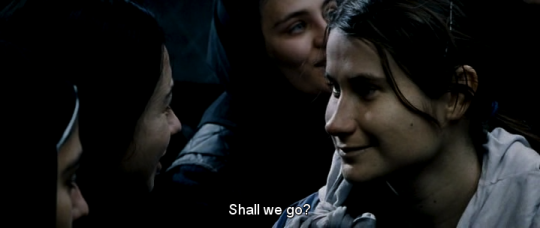
Spoilers.
I saw this six months ago when it came out at the cinema. It is almost as spare as Cristian Mungiu’s first film, 4 Months, 3 Weeks and 2 Days. But the film-making draws even less attention to itself. 4 Months… was sometimes so naturalistic that it was a little showy: the long supper scene with the static camera, the scene where the camera waits in the bathroom while each of the women go out to the bedroom to have sex with the man who performs the abortion.
Beyond the Hills is wonderful because the central relationship between the two women (second from left and on the right) is a complete mystery. What were they to each other before they were reunited at the convent? Why does the devout woman quietly and tenderly absorb the other’s affection and neither reject her nor let her in? Why does she finally decide to cast her lot in with her friend and leave the convent?
In the still above, the devout nun finally casts in her lot with her friend and her friend smiles and then dies. It makes me cry whenever I think about it.
#notebook #medianotes
Colin Stetson, Among the Sef
06 among the sef.mp3
I love the way the sound of the saxophone dies away, just leaving the clacking of the keys. I love how the song feels both frenetic and mournful, like it’s a desperate attempt to save something that is slipping away.
This song reminds me of the summer just gone. Of floating around New York in the baking heat and going to the cinema three times in one weekend.
#notebook
Colin Stetson, Among the Sef
06 among the sef 2.mp3
I love the way the sound of the saxophone dies away, just leaving the clacking of the keys. I love how the song feels both frenetic and mournful, like it’s a desperate attempt to save something that is slipping away.
This song reminds me of the summer just gone. Of floating around New York in the baking heat and going to the cinema three times in one weekend.
#notebook #medianotes
Beach House, On the Sea
09 On the Sea.mp3
I adore the vibrato guitar. I adore the melody that falls, then steps up one tone, then falls again: “Whistle to a friend. Gentle till the end. Anyway in a name she takes shape just the same.” And I love love love the line: “Wouldn’t you like to know how far you’ve got left to go?”
#notebook
Beach House, On the Sea
09 On the Sea 2.mp3
I adore the vibrato guitar. I adore the melody that falls, then steps up one tone, then falls again: “Whistle to a friend. Gentle till the end. Anyway in a name she takes shape just the same.” And I love love love the line: “Wouldn’t you like to know how far you’ve got left to go?”
#notebook #medianotes
Blue is the Warmest Colour
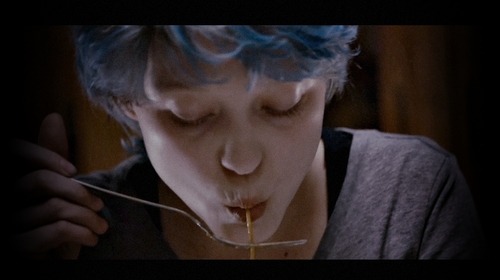
It’s really hard to choose any stills from this film. Most of them are either beautiful and, so, make the film seem trite, or mundane and, so, make the film seem empty. The one I wanted was of Adèle floating in the sea, finally able to get away from her own emotions and the tumult of circumstances that life has imposed on her. But the stills I could find of that look too sexualised and miss the point.
I chose the shot above. It’s at once down to earth and nicely composed.
It’s rare for a film to take you on a journey, where you think back to the start and can’t believe how much everyone has changed. Malcolm X did this. And Blue is the Warmest Colour does this.
The sex scenes, certainly in the way they have affected the film’s reception, are a distraction. It’s the emotional honesty of the film that is great. But, in the internal logic of the film, the sex scenes are appropriate. The director is trying to show emotions in raw form. The sex scenes are one of the expressions of that. They are, like the the snot that runs down Adèle’s lip when she cries, a way of saying: “If you want raw, I’ve got raw. You may think that two women having sex is sexy, but it is a mixture of crude and funny and sexy and beautiful. Like sex.”
My favourite line comes when the relationship is breaking down. Emma the painter says to Adèle the schoolteacher, of the woman Emma is flirting with at a party:
“She’s a painter, too.”
#notebook
Blue is the Warmest Colour
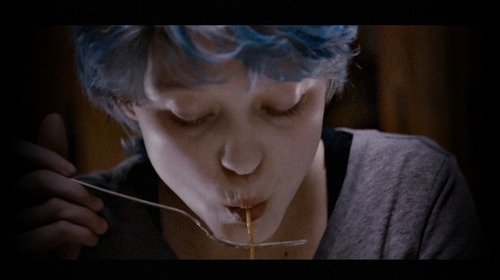
It’s really hard to choose any stills from this film. Most of them are either beautiful and, so, make the film seem trite, or mundane and, so, make the film seem empty. The one I wanted was of Adèle floating in the sea, finally able to get away from her own emotions and the tumult of circumstances that life has imposed on her. But the stills I could find of that look too sexualised and miss the point.
I chose the shot above. It’s at once down to earth and nicely composed.
It’s rare for a film to take you on a journey, where you think back to the start and can’t believe how much everyone has changed. Malcolm X did this. And Blue is the Warmest Colour does this.
The sex scenes, certainly in the way they have affected the film’s reception, are a distraction. It’s the emotional honesty of the film that is great. But, in the internal logic of the film, the sex scenes are appropriate. The director is trying to show emotions in raw form. The sex scenes are one of the expressions of that. They are, like the the snot that runs down Adèle’s lip when she cries, a way of saying: “If you want raw, I’ve got raw. You may think that two women having sex is sexy, but it is a mixture of crude and funny and sexy and beautiful. Like sex.”
My favourite line comes when the relationship is breaking down. Emma the painter says to Adèle the schoolteacher, of the woman Emma is flirting with at a party:
“She’s a painter, too.”
#notebook #medianotes
The only bit I really liked from Masculin Feminin
The only bit I really liked from Masculin Feminin
Heat
One of the things I like about Michael Mann is that I don’t understand a lot of his decisions. I don’t mean that I see his choice and its aim and that I disagree. I don’t mean I see his choice and think he has missed his aim. I mean I don’t see the choice he made. For example, I have no idea why the opening shot has a train in it, why there is smoke blowing across the screen, why it is night time, or why the camera is on the railway tracks.
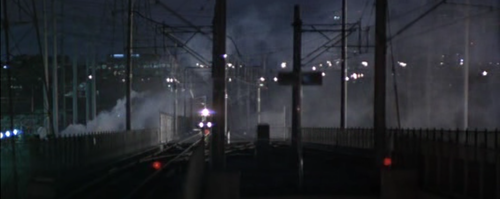
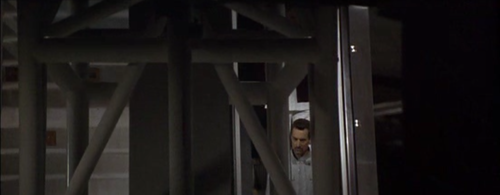
There is something interesting about the way the man adjusts his glasses that feels so real, even though you are unnaturally close to his face.
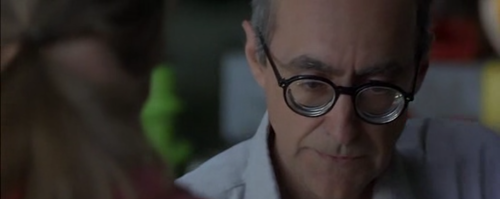
Note in the background the portentous painting of the girl.
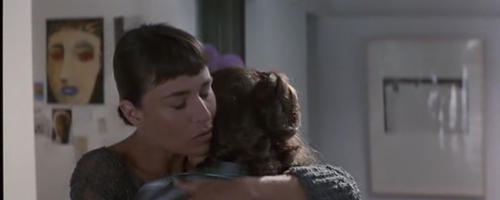
So much of Heat is shot panoramically. Even the little domestic scene where Hanna comes home late and hasn’t called and his wife has been waiting is shot in these great wide vistas. There are yards of space either side of him as he furtively looks up the stairs to see if it is safe to turn on the TV. These yards are used for informative things like the end of the dining table with candle and places for two, and also uninformative things like the great gap between Hanna and the TV and the part of a book shelf.
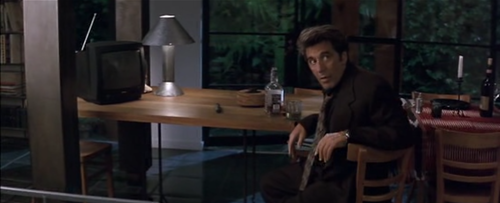
One could say this decision is about distancing the characters from each other, or showing a home that is mostly empty, or making the street environment spill into Hanna’s home life. Any which way, it makes the Hitchcockian front-on shots all the more arresting. It makes these moments almost the only times when two people actually focus on each other, rather than being drowned in the sea of space between them. Even if that focus or moment of interaction is between a man and the man he is about to kill.
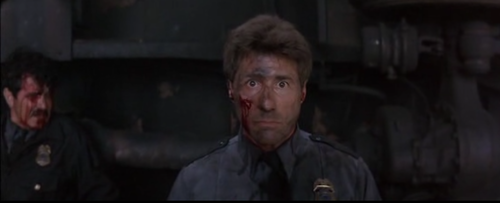
Despite the fact that the men in this shot are moving about all over the place, they are laid out as well as a painting.
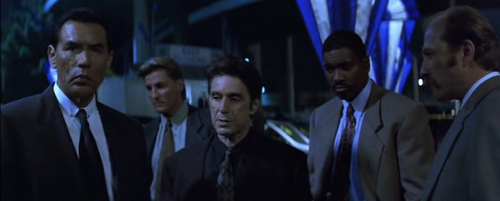
It would be trite to call Mann’s landscapes barren or desolate or real, though they are sometimes all these things. I think the overarching feeling is of existence. That there are places like these everywhere, and some of them are the stages for fantastical events like the ones depicted in the film you are watching. They are places where you are alone and, and though nothing is happening at this moment, attention is focused on you.
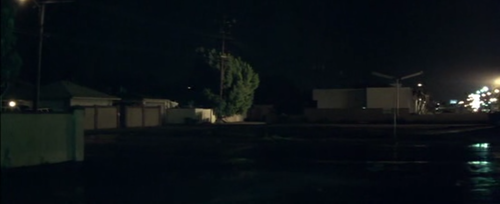
Mann is famous for shots like this:
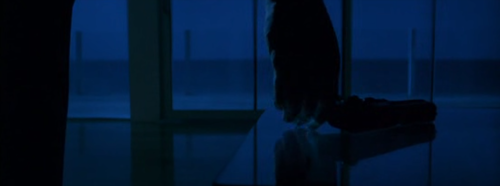
The cold, blue light appears in Manhunter relatively frequently. But, in his other films, it’s quite rare. Since Collateral, it has almost completely disappeared, replaced by the sodium yellow of street lights that show up on his new, digital cameras. The yellow is far more interesting, because it is a colour we all inhabit. This realism is echoed in the new way he does the sound effects for guns. In Heat and earlier films, the guns made KABLAOWW type sounds that were designed to sound as powerful as possible. From Miami Vice on, the guns made that muffled, low-down-to-the-ground staccato you hear on news coverage of urban wars.
Mann sometimes brazenly disregards authenticity. In the scene at the end of The Last of the Mohicans, when the English girl throws herself off the cliff top after her dead beloved, the light upon the valley is completely different from the light on the characters’ faces when they are talking. In this scene in Heat, the light on Eady’s face makes the whole scene seem unreal, like the thank you letter in Taxi Driver.
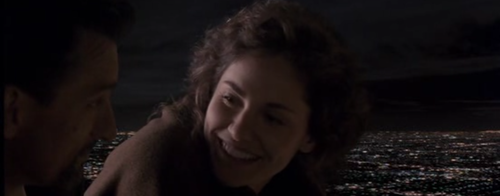
Sometimes, shots in Heat seem messy, because there is so much stuff being shown. Cars parked in the street. Books on a table. But it’s all deliberate. Look at how acetic this shot is:
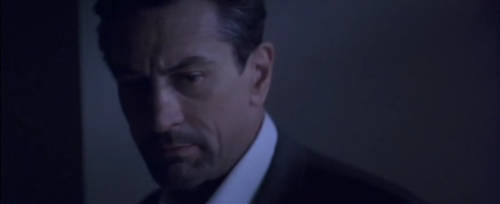
I love this shot so much:
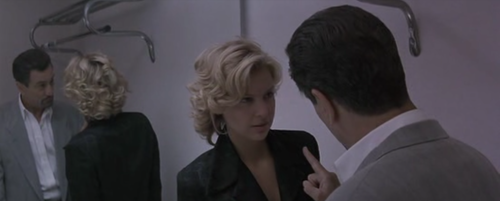
Another straight-on shot showing a tender moment of human connection: McCauley telling Van Zant he is going to kill him.
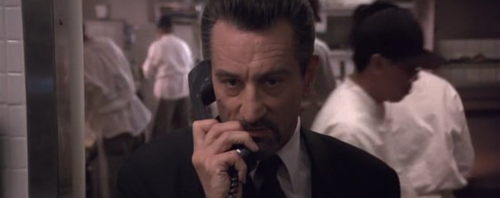
Another straight-on shot. This time, the background is distant and Hanna is completely alone in the green cold.
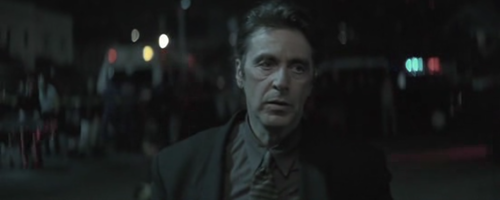
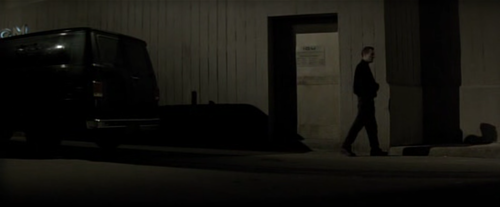
The straight-on shots, though often about impending death, are also about recognition. I find great meaning in fact that Hanna and McCauley are the only characters who really understand each other. These two shots are where it begins:
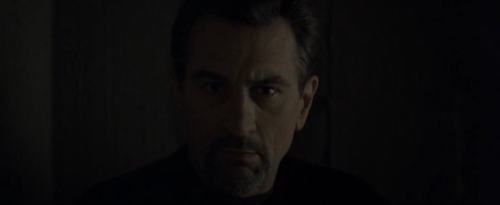
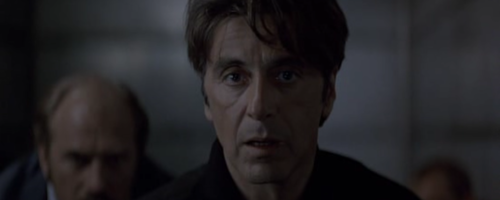
The robbers watching the cops

When McCauley walks into the bank, that click click click music sets the pace for the final part of the film. Though it doesn’t feel like it. Part of the reason the shoot-out is so wonderful is that is happens in what feels like the middle of the film. But this is where an unstoppable series of events happen over a few days that feel like a line of dominoes going over.
I love the change of Val Kilmer’s face when he sees the police.
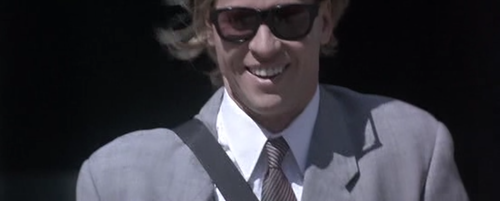
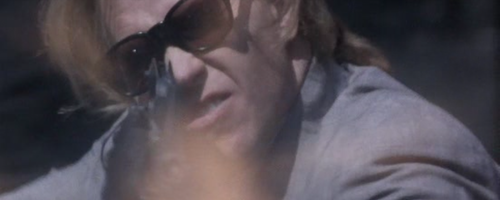
And the final straight-on shots.
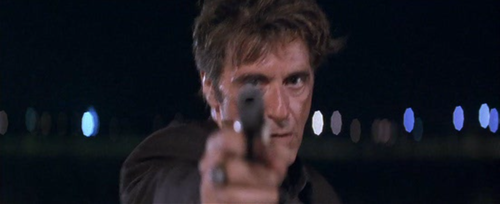
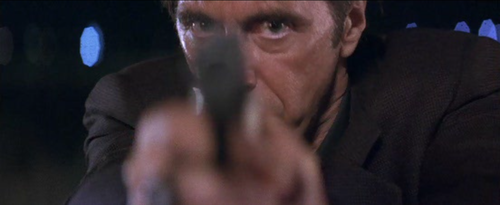
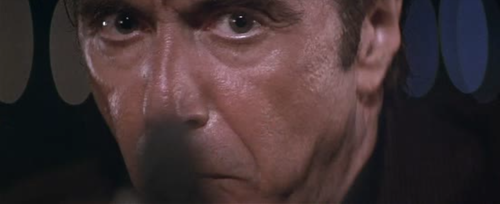
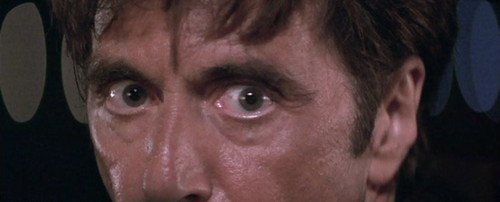
Strangely, not mirrored from Hanna’s perspective.
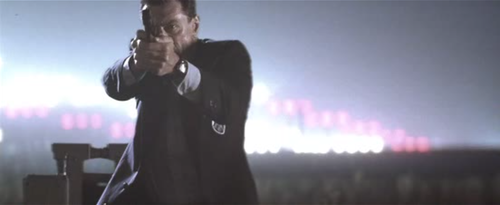
The final frame. Aeroplanes landing to mirror the trains arriving in the first scene.
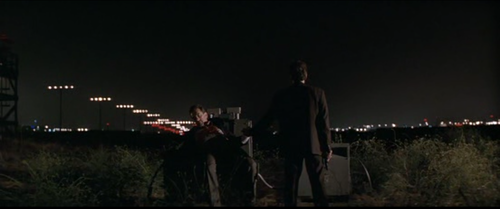
#notebook
Heat
One of the things I like about Michael Mann is that I don’t understand a lot of his decisions. I don’t mean that I see his choice and its aim and that I disagree. I don’t mean I see his choice and think he has missed his aim. I mean I don’t see the choice he made. For example, I have no idea why the opening shot has a train in it, why there is smoke blowing across the screen, why it is night time, or why the camera is on the railway tracks.
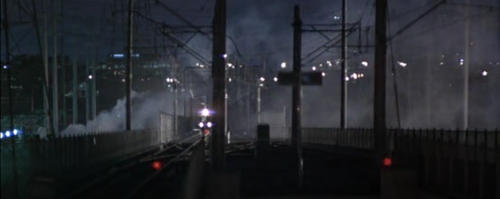
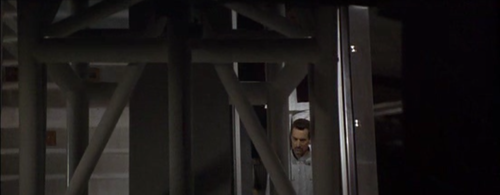
There is something interesting about the way the man adjusts his glasses that feels so real, even though you are unnaturally close to his face.
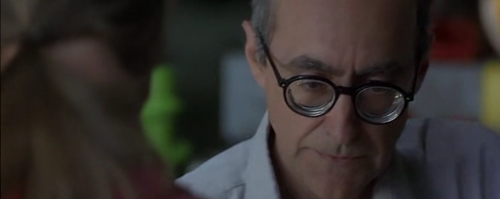
Note in the background the portentous painting of the girl.
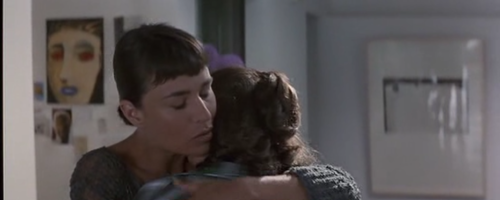
So much of Heat is shot panoramically. Even the little domestic scene where Hanna comes home late and hasn’t called and his wife has been waiting is shot in these great wide vistas. There are yards of space either side of him as he furtively looks up the stairs to see if it is safe to turn on the TV. These yards are used for informative things like the end of the dining table with candle and places for two, and also uninformative things like the great gap between Hanna and the TV and the part of a book shelf.
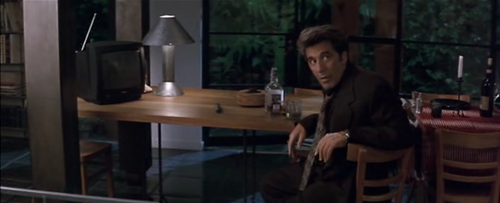
One could say this decision is about distancing the characters from each other, or showing a home that is mostly empty, or making the street environment spill into Hanna’s home life. Any which way, it makes the Hitchcockian front-on shots all the more arresting. It makes these moments almost the only times when two people actually focus on each other, rather than being drowned in the sea of space between them. Even if that focus or moment of interaction is between a man and the man he is about to kill.
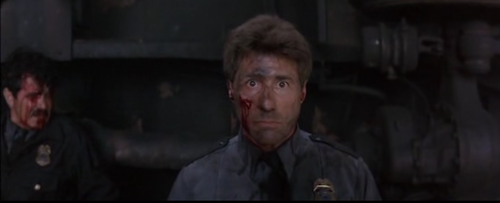
Despite the fact that the men in this shot are moving about all over the place, they are laid out as well as a painting.
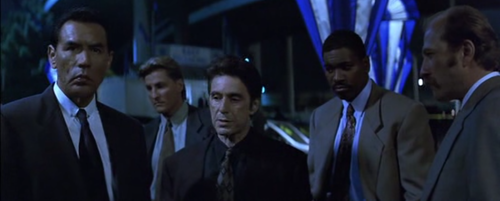
It would be trite to call Mann’s landscapes barren or desolate or real, though they are sometimes all these things. I think the overarching feeling is of existence. That there are places like these everywhere, and some of them are the stages for fantastical events like the ones depicted in the film you are watching. They are places where you are alone and, and though nothing is happening at this moment, attention is focused on you.
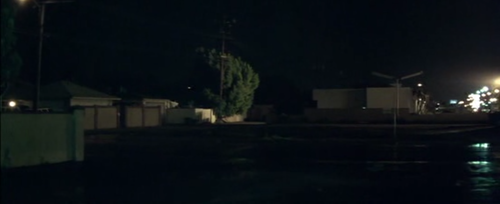
Mann is famous for shots like this:
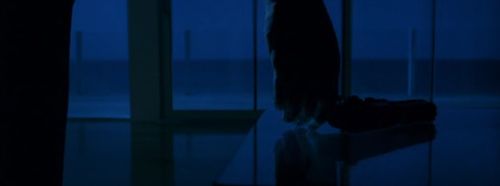
The cold, blue light appears in Manhunter relatively frequently. But, in his other films, it’s quite rare. Since Collateral, it has almost completely disappeared, replaced by the sodium yellow of street lights that show up on his new, digital cameras. The yellow is far more interesting, because it is a colour we all inhabit. This realism is echoed in the new way he does the sound effects for guns. In Heat and earlier films, the guns made KABLAOWW type sounds that were designed to sound as powerful as possible. From Miami Vice on, the guns made that muffled, low-down-to-the-ground staccato you hear on news coverage of urban wars.
Mann sometimes brazenly disregards authenticity. In the scene at the end of The Last of the Mohicans, when the English girl throws herself off the cliff top after her dead beloved, the light upon the valley is completely different from the light on the characters’ faces when they are talking. In this scene in Heat, the light on Eady’s face makes the whole scene seem unreal, like the thank you letter in Taxi Driver.
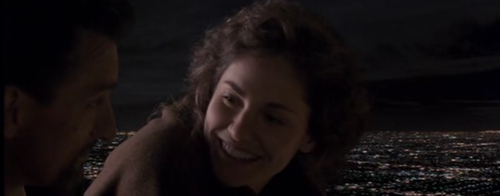
Sometimes, shots in Heat seem messy, because there is so much stuff being shown. Cars parked in the street. Books on a table. But it’s all deliberate. Look at how acetic this shot is:
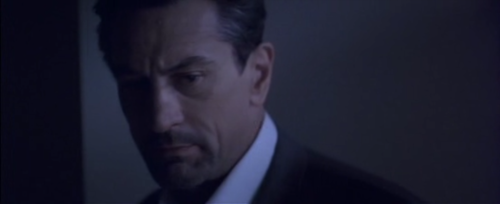
I love this shot so much:
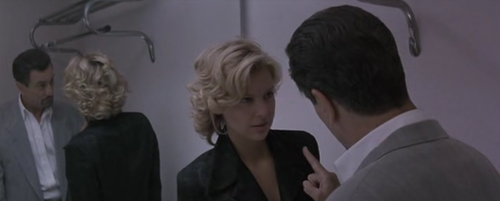
Another straight-on shot showing a tender moment of human connection: McCauley telling Van Zant he is going to kill him.
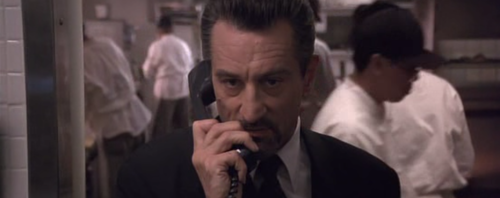
Another straight-on shot. This time, the background is distant and Hanna is completely alone in the green cold.
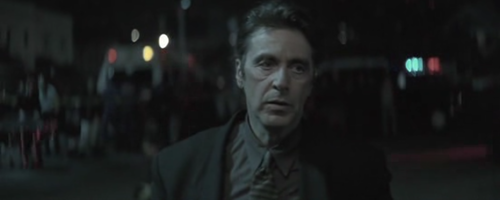
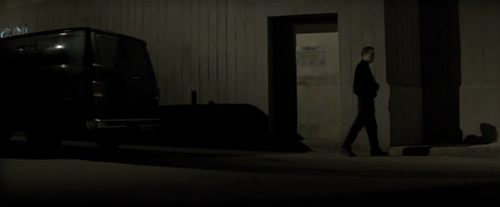
The straight-on shots, though often about impending death, are also about recognition. I find great meaning in fact that Hanna and McCauley are the only characters who really understand each other. These two shots are where it begins:
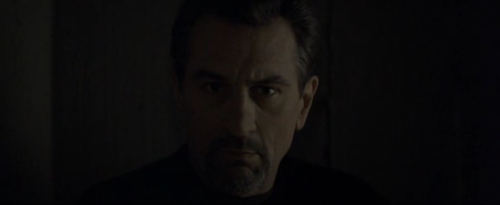
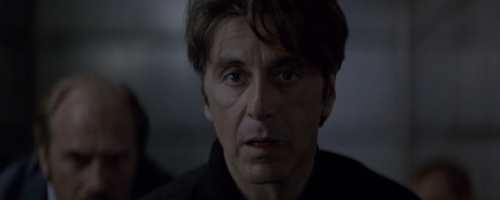
The robbers watching the cops

When McCauley walks into the bank, that click click click music sets the pace for the final part of the film. Though it doesn’t feel like it. Part of the reason the shoot-out is so wonderful is that is happens in what feels like the middle of the film. But this is where an unstoppable series of events happen over a few days that feel like a line of dominoes going over.
I love the change of Val Kilmer’s face when he sees the police.
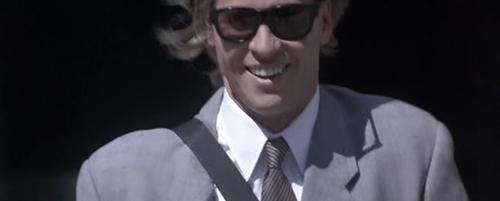
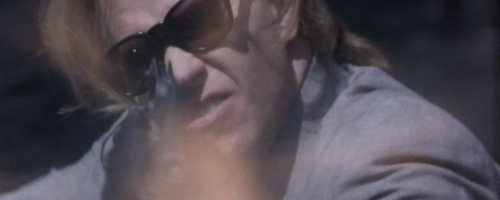
And the final straight-on shots.
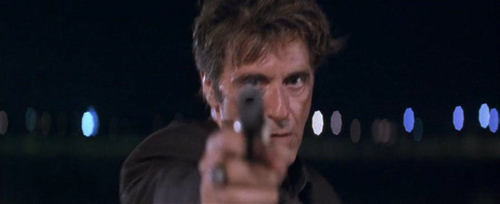
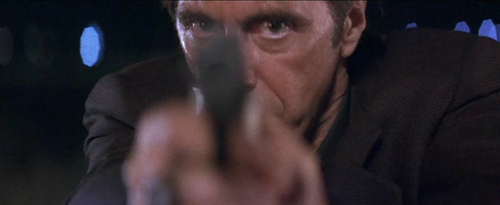
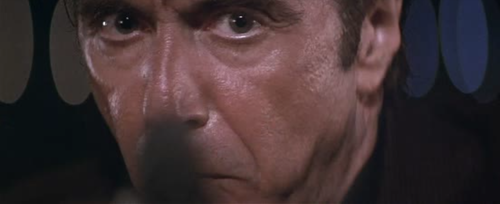
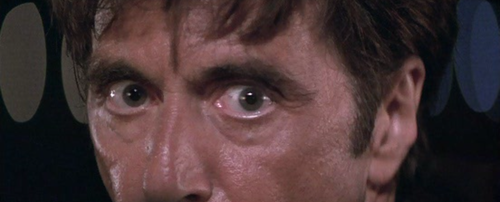
Strangely, not mirrored from Hanna’s perspective.
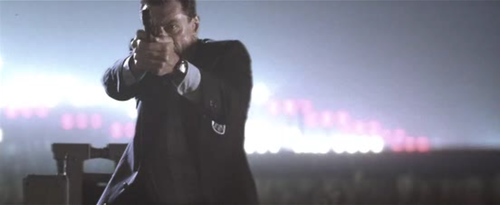
The final frame. Aeroplanes landing to mirror the trains arriving in the first scene.
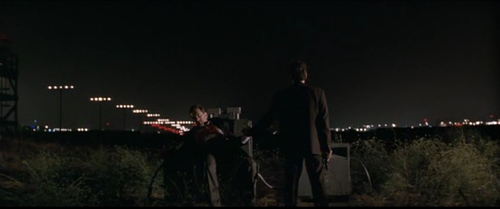
#notebook #medianotes
Tristan Perich, MOMA
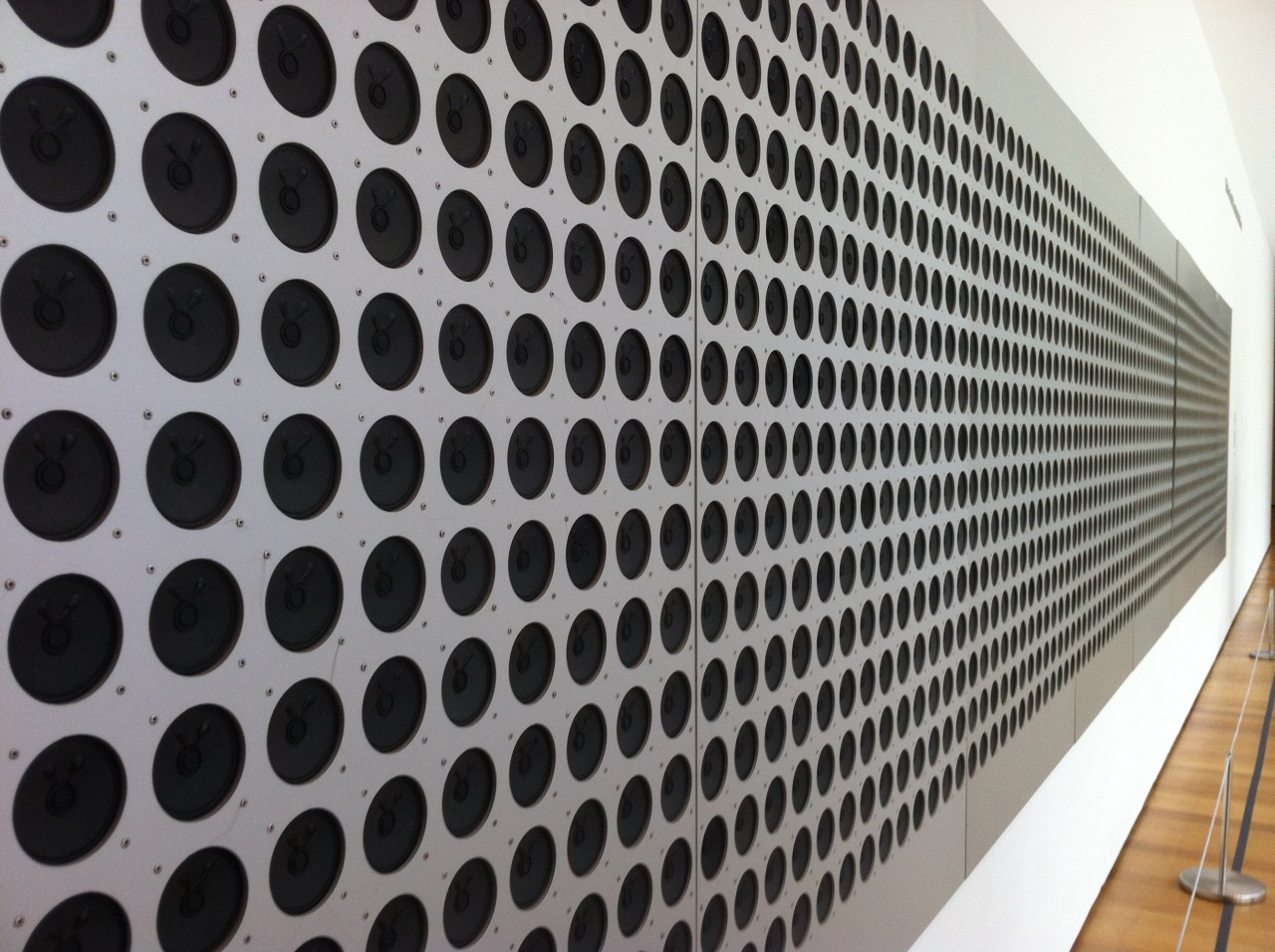
1500 one-bit speakers, each playing a different pitch. Moving around in front of the exhibit produced a great variety of auditory hallucinations.
#notebook
Tristan Perich, MOMA
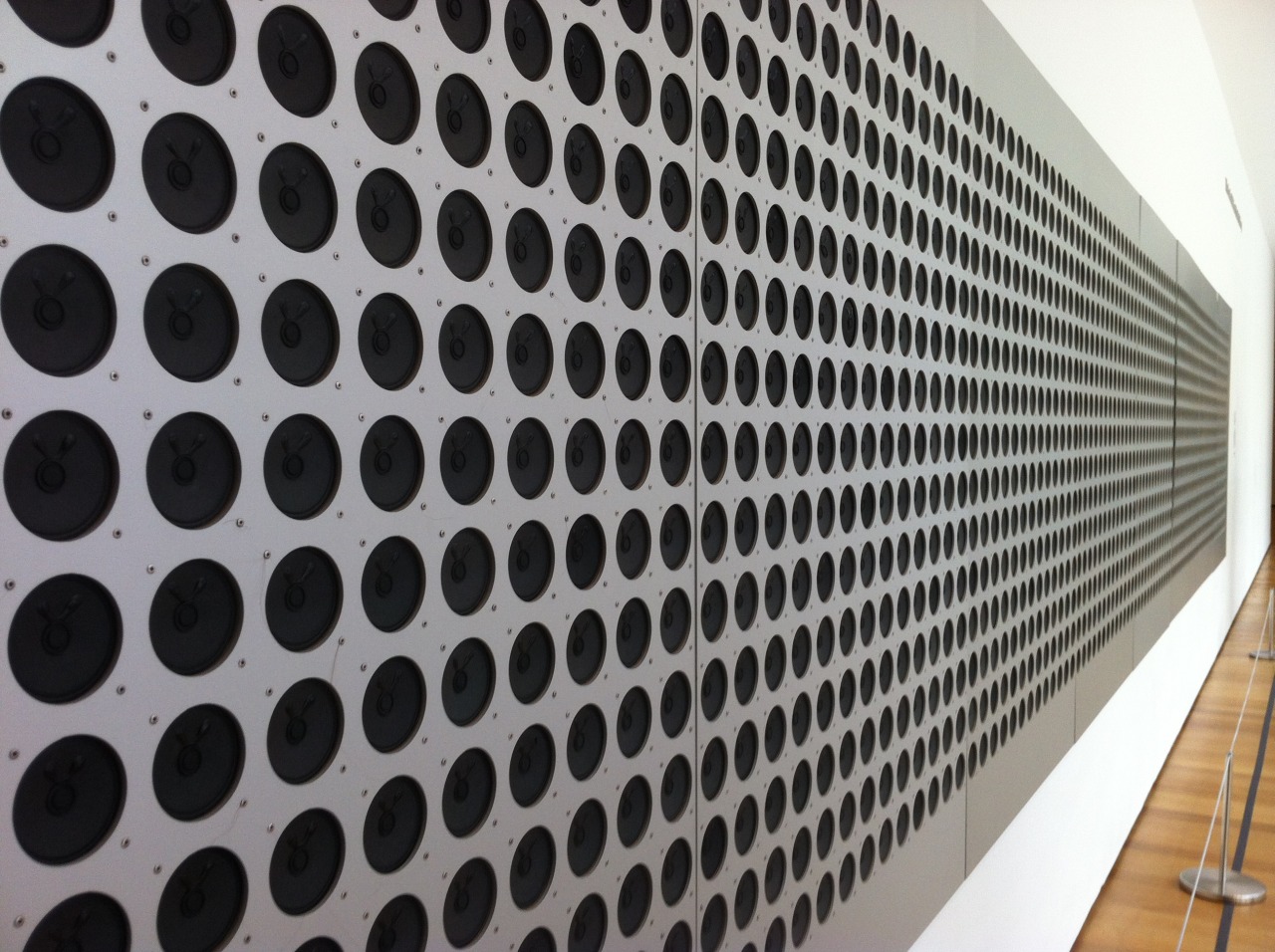
1500 one-bit speakers, each playing a different pitch. Moving around in front of the exhibit produced a great variety of auditory hallucinations.
#notebook #medianotes
Design is One
A documentary about Lella and Massimo Vignelli. Mostly fawning interviews with colleagues and unenlightening interviews with the subjects about their working relationship. These moments stood out:
An examination of how Massimo chooses typefaces. “He thinks about it carefully, then chooses Helvetica.” He listed a few serif typefaces as worthwhile: Times New Roman, Garamond, Bodini. And a few sans serif typefaces: Helvetica, Futura.
The examples of him using a grid system for layout.
The cup and saucer he designed for Heller. Users complained about the original version, saying that the half-moon cut out for the U-shape of the handle let the contents spill out. The version in wide use had that hole plugged by a piece of plastic. See the picture below. Massimo complained that the complainers were unsophisticated: the cup was designed for drinking demi-tasse, and should not be filled to the brim.
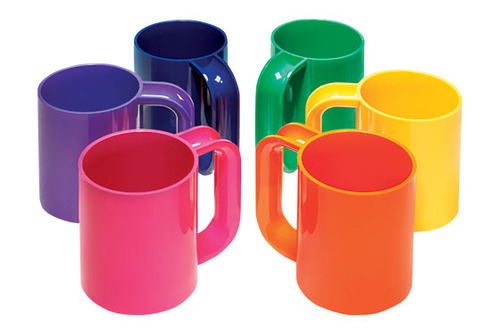
#notebook
Design is One
A documentary about Lella and Massimo Vignelli. Mostly fawning interviews with colleagues and unenlightening interviews with the subjects about their working relationship. These moments stood out:
An examination of how Massimo chooses typefaces. “He thinks about it carefully, then chooses Helvetica.” He listed a few serif typefaces as worthwhile: Times New Roman, Garamond, Bodini. And a few sans serif typefaces: Helvetica, Futura.
The examples of him using a grid system for layout.
The cup and saucer he designed for Heller. Users complained about the original version, saying that the half-moon cut out for the U-shape of the handle let the contents spill out. The version in wide use had that hole plugged by a piece of plastic. See the picture below. Massimo complained that the complainers were unsophisticated: the cup was designed for drinking demi-tasse, and should not be filled to the brim.
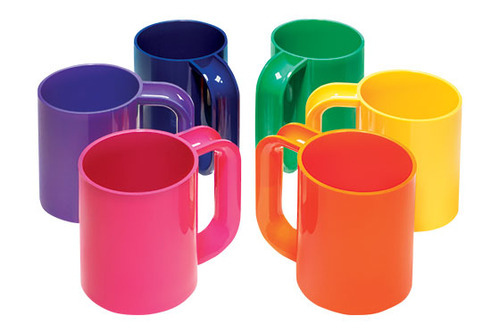
#notebook #medianotes
Chronicle
Chronicle
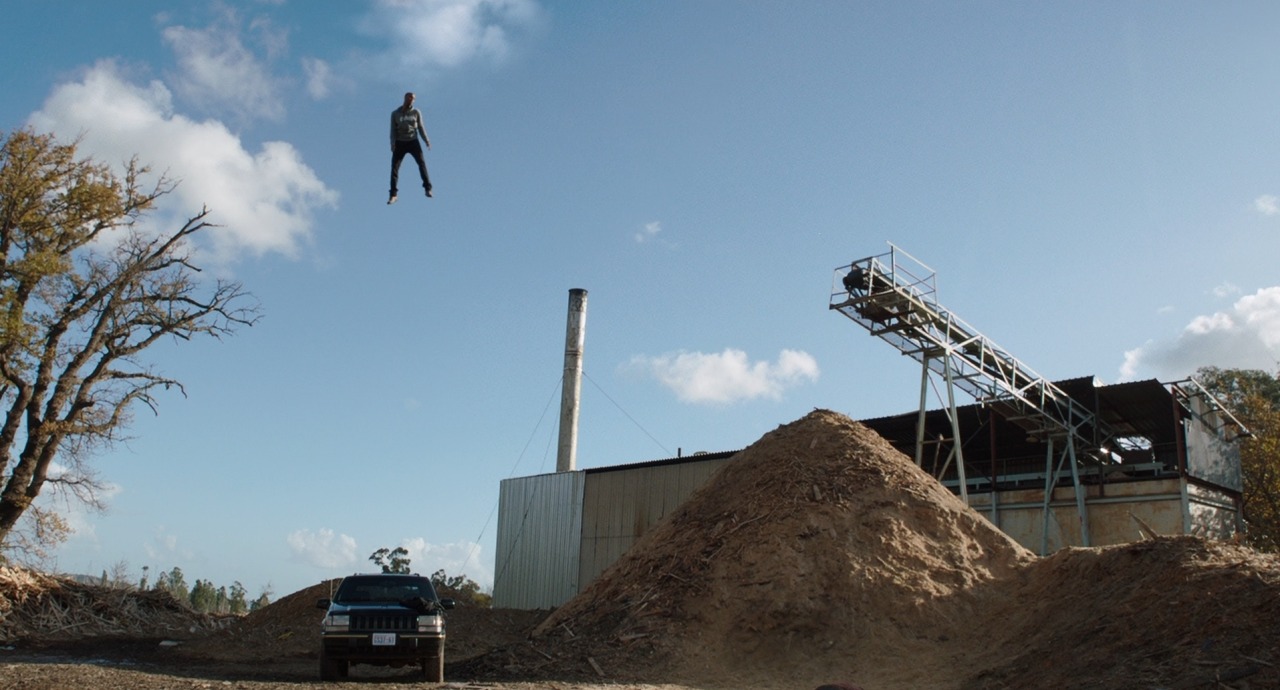
I saw [this](https://en.wikipedia.org/wiki/Chronicle_(film)) on an aeroplane seat TV screen, and I was still completely entranced. It takes a premise and follows it logically, soberly and ruthlessly to a conclusion.
#notebook #medianotes
GTA V
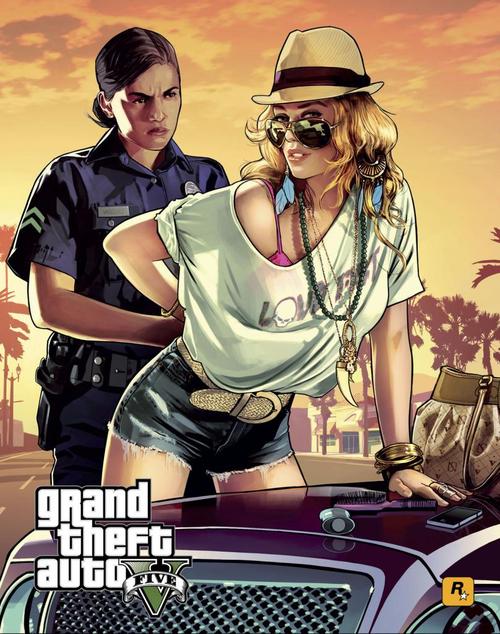
#notebook
GTA V
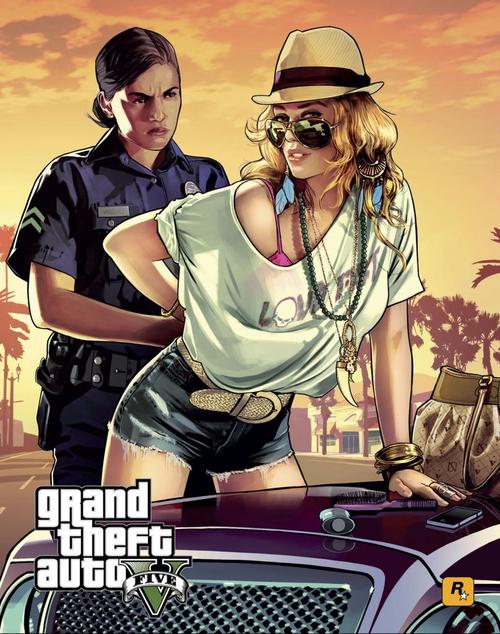
#notebook #medianotes
Le Joli Mai
Le Joli Mai
Le Mepris
I saw this at Film Forum tonight. It was an unending fountain of ideas.
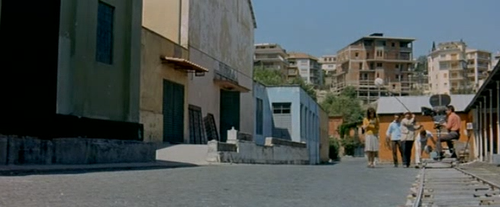
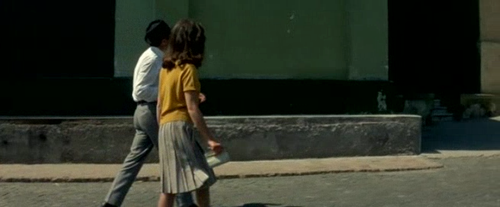
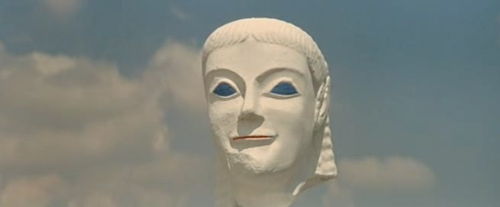
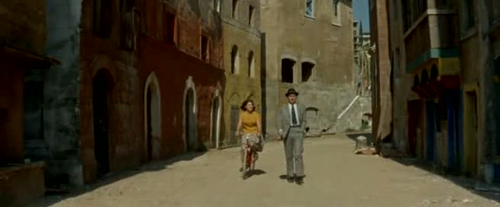
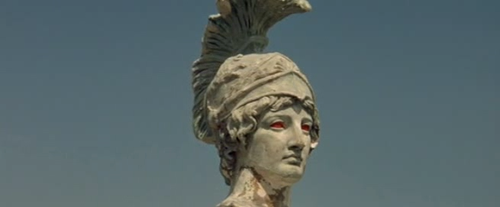
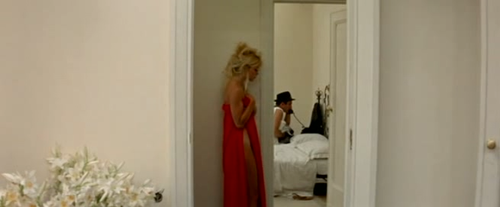
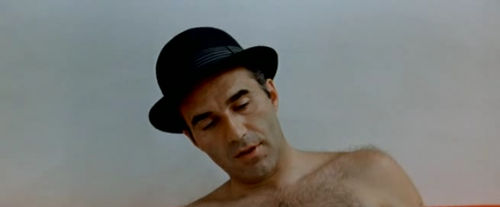
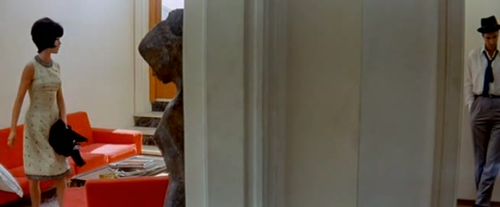
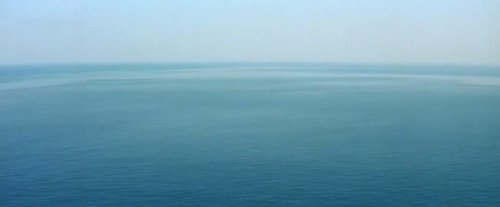
#notebook
Le Mepris
I saw this at Film Forum tonight. It was an unending fountain of ideas.
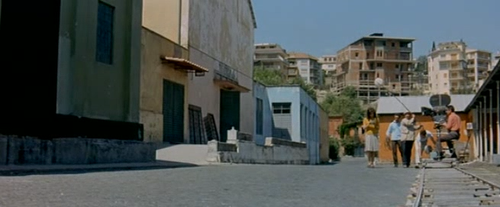
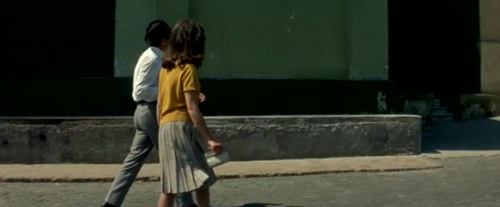
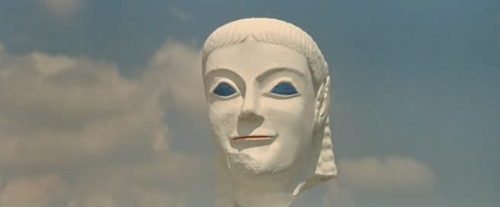
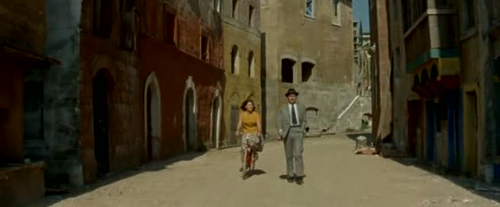
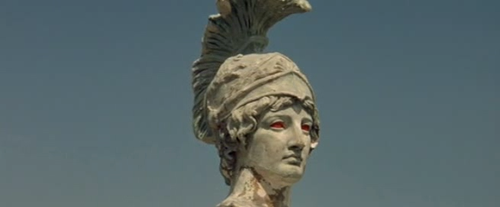
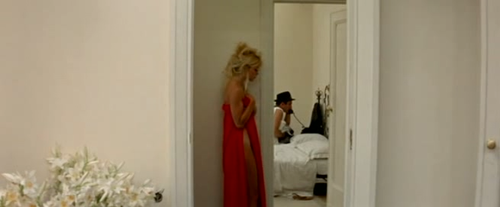
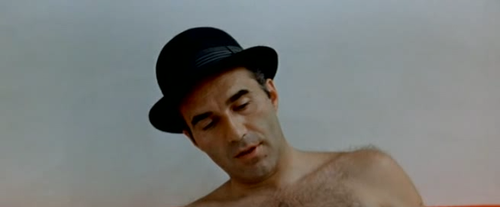
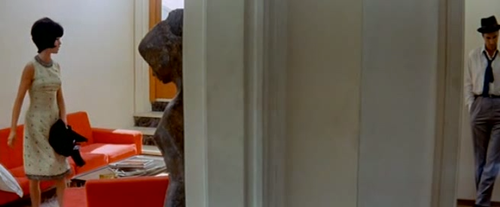
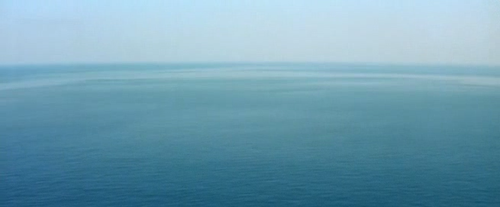
#notebook #medianotes
Chromatics, These Streets Will Never Look the Same
Kill for Love, the record from which this song comes, is the soundtrack to winter 2013, just like Beach House’s Teen Dream was the soundtrack to summer 2010 in Berlin. Both are synthy pop, which is not normally my sort of thing. But both records are deep and versatile. They work when walking through the street at four p.m. or seven a.m. They work when writing code. They can conjure romantic associations.
#notebook
Chromatics, These Streets Will Never Look the Same
Kill for Love, the record from which this song comes, is the soundtrack to winter 2013, just like Beach House’s Teen Dream was the soundtrack to summer 2010 in Berlin. Both are synthy pop, which is not normally my sort of thing. But both records are deep and versatile. They work when walking through the street at four p.m. or seven a.m. They work when writing code. They can conjure romantic associations.
#notebook
Sleater Kinney, Good Things
Sleater Kinney, Good Things
A song composed of nerdy pick-up lines
Nerdy Love Song with Added Kitten Bonus! - YouTube
I feel like in a year I will look back and be embarrassed I posted this. Or maybe I will be a huge softie by then and love it. Any which way, right now, it is pretty great.
“I want to be your abacus, baby. You can count on me.”
“I less than three you.”
#notebook
A song composed of nerdy pick-up lines
Nerdy Love Song with Added Kitten Bonus! - YouTube
I feel like in a year I will look back and be embarrassed I posted this. Or maybe I will be a huge softie by then and love it. Any which way, right now, it is pretty great.
“I want to be your abacus, baby. You can count on me.”
“I less than three you.”
#notebook
The Last of Us

Spoilers
I cried several times. I particularly enjoyed the passage where you switch back and forth between Ellie and Joel.
#notebook #medianotes
The Last of Us

Spoilers
I cried several times. I particularly enjoyed the passage where you switch back and forth between Ellie and Joel.
#notebook
How to Read a Film, James Monaco
Abstraction - pure form - became the touchstone of the work of art and the main criterion by which works of art were judged in the twentieth century.
#notebook
How to Read a Film, James Monaco
Abstraction - pure form - became the touchstone of the work of art and the main criterion by which works of art were judged in the twentieth century.
#notebook
The Mosquito Coast
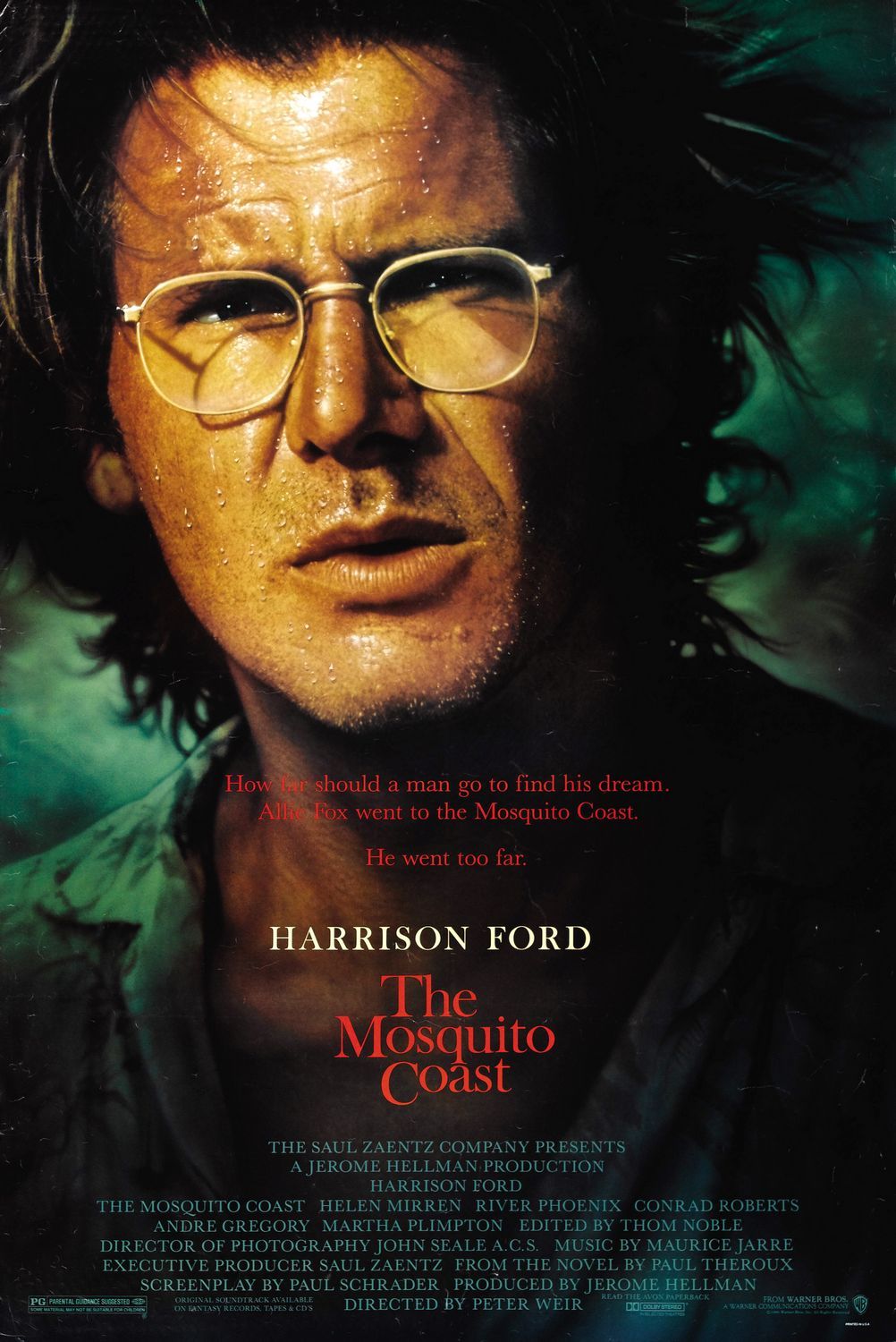
The film completely falls apart in the second half. But there are some wonderful bits. The gravity-powered ceiling fan that has to be periodically cranked. The man-made ice that melts away in the jungle. The regularisation of nature by sheer will.
No still from the film is appropriate. I could have put up a clip of Ford pacing around as he talks about his building plans, the camera barely able to keep up with him. I could have put in the clip where Ford realises the people are taking the ice for granted. But the poster is the best still. The way Ford looks puzzled, and wistful, and like he is looking at a glorious future he can just make out in the distance.
#notebook
The Mosquito Coast
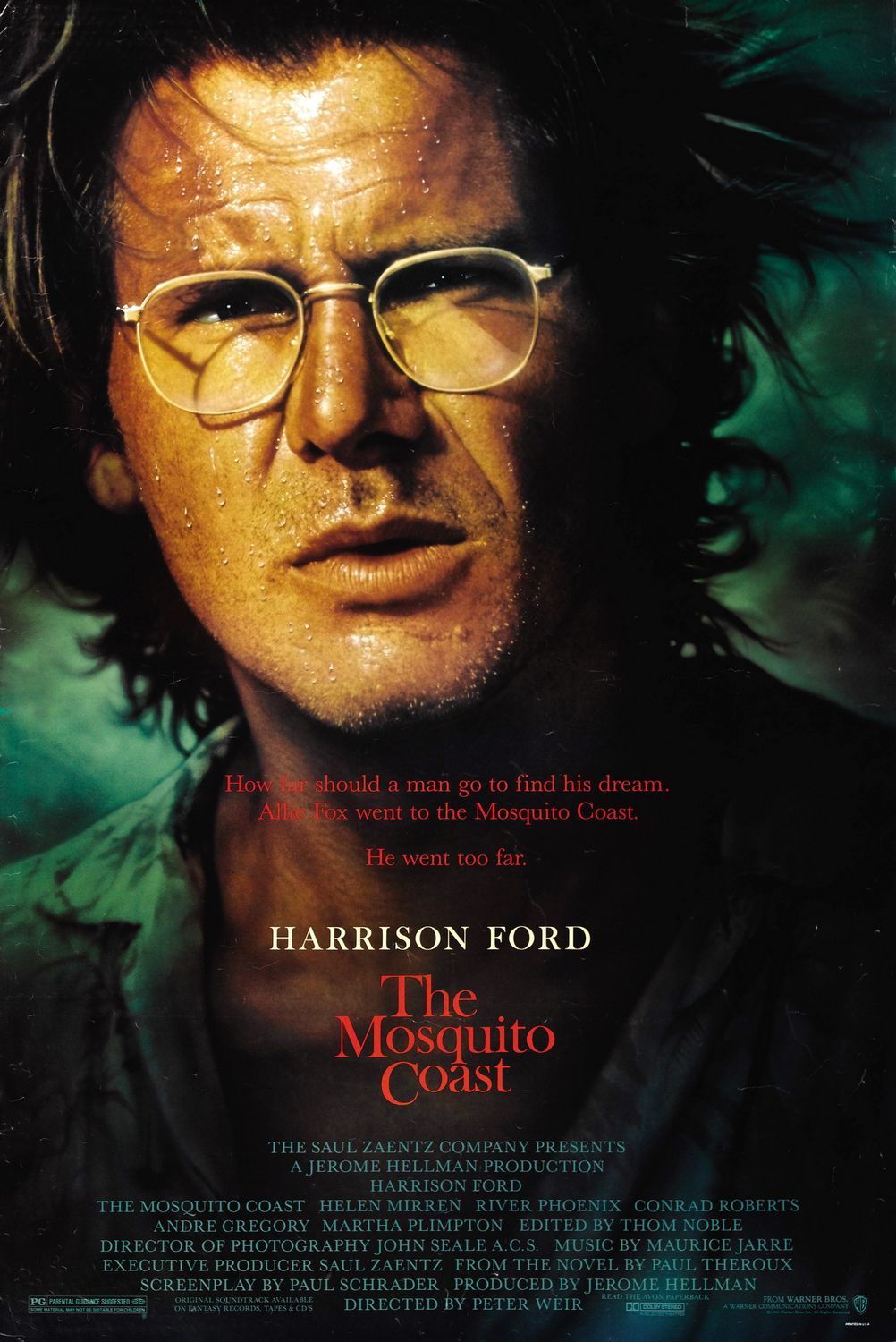
The film completely falls apart in the second half. But there are some wonderful bits. The gravity-powered ceiling fan that has to be periodically cranked. The man-made ice that melts away in the jungle. The regularisation of nature by sheer will.
No still from the film is appropriate. I could have put up a clip of Ford pacing around as he talks about his building plans, the camera barely able to keep up with him. I could have put in the clip where Ford realises the people are taking the ice for granted. But the poster is the best still. The way Ford looks puzzled, and wistful, and like he is looking at a glorious future he can just make out in the distance.
#notebook #medianotes
The air
The air with which Lea Massari moves through the hours before her disappearance in L'Avventura is like the way the girls walk up the stone formation before disappearing in Picnic at Hanging Rock . Even before they go, they’re already gone.
#notebook
The air
The air with which Lea Massari moves through the hours before her disappearance in L'Avventura is like the way the girls walk up the stone formation before disappearing in Picnic at Hanging Rock . Even before they go, they’re already gone.
#notebook
Your Sister’s Sister
Your Sister's Sister - Wikipedia
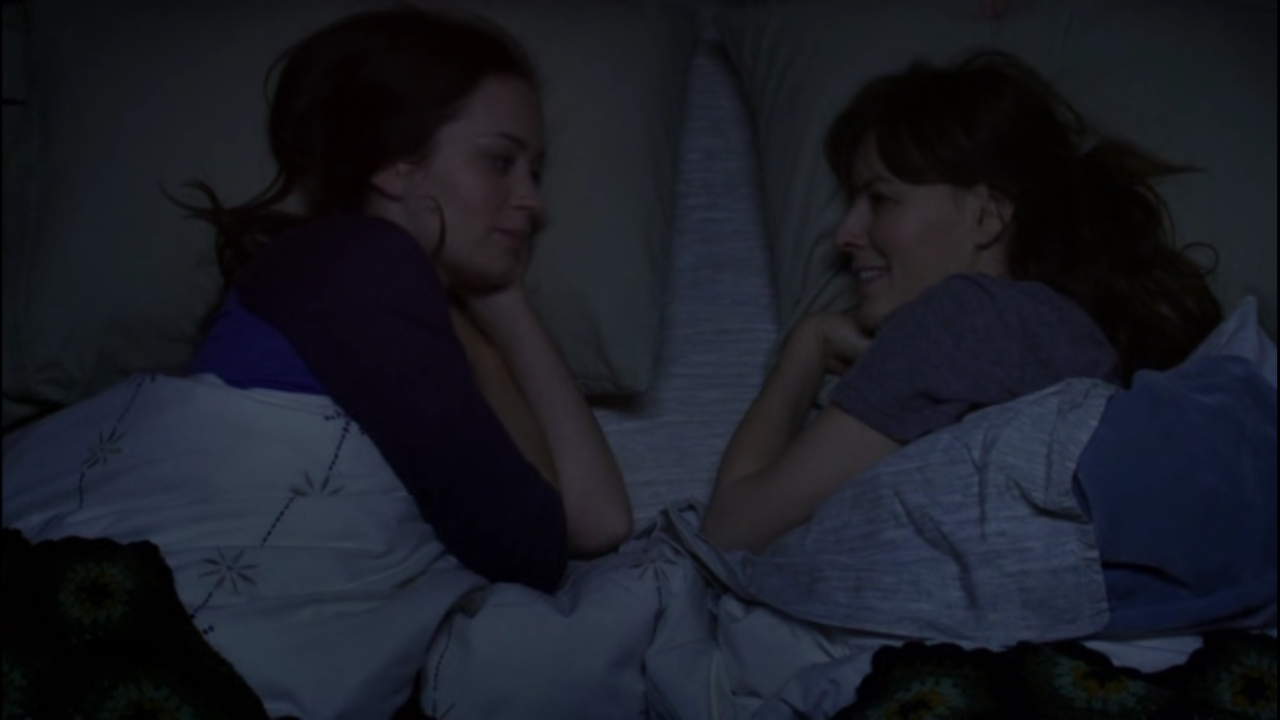
Another very truthy film from Lynn Shelton. Though the plot is fantastical, the sober writing and acting keep it feeling real.
#notebook
Your Sister’s Sister
Your Sister's Sister - Wikipedia
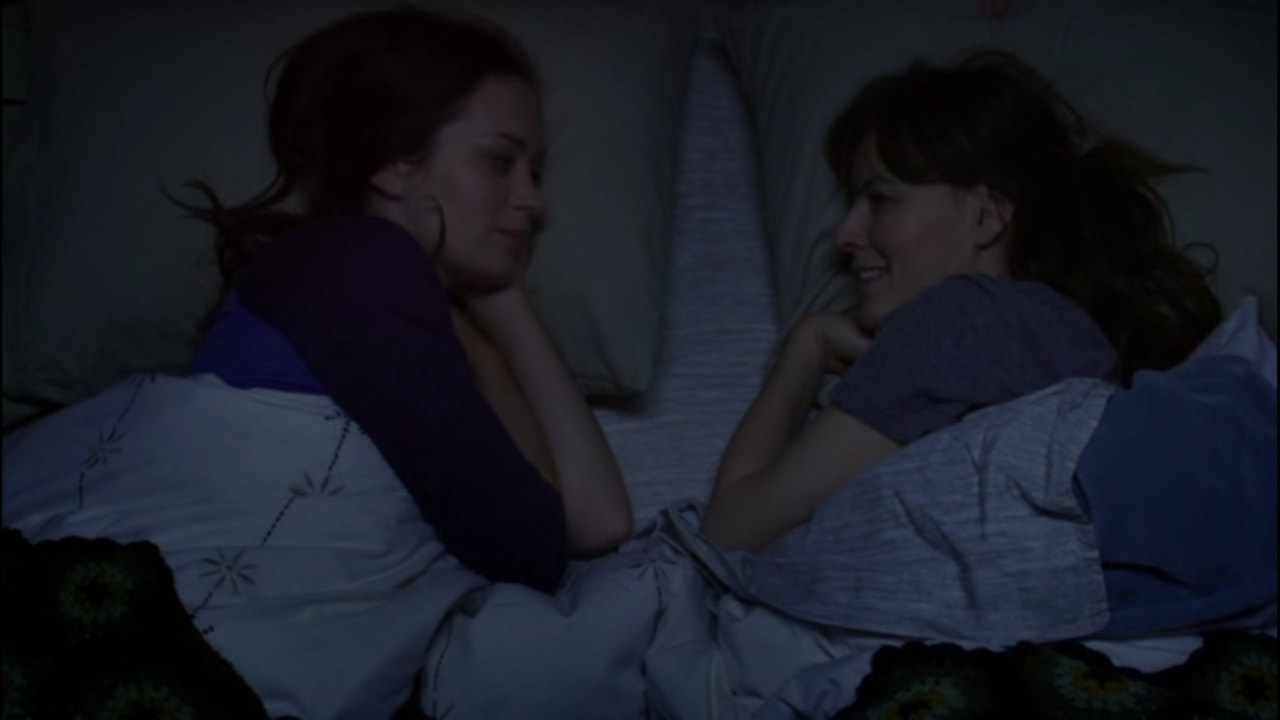
Another very truthy film from Lynn Shelton. Though the plot is fantastical, the sober writing and acting keep it feeling real.
#notebook #medianotes
The Frick
On Sunday, I went to the Frick, which knocked me sideways. It was like being in the Wallace, except even more intimate. Seeing those paintings in a (relatively) every day environment made them much more moving.
There was Adoration of the Magi by Bastini. Everyone looking at Jesus but bad-tempered Joseph, and Jesus looking at Mary. That wonderful circle of red from smock to armour to blouse to hat.

One of my faves was Lippi’s Annunciation. I like the fact that he decided to make both Mary and Gabriel deferential to each other. I like the great pillar between them. And I found it so interesting that, like so many medieval and early Renaissance paintings, the events take place in a weird, barren, classical room with a wall missing that reveals nothingness.

Mrs Baker.
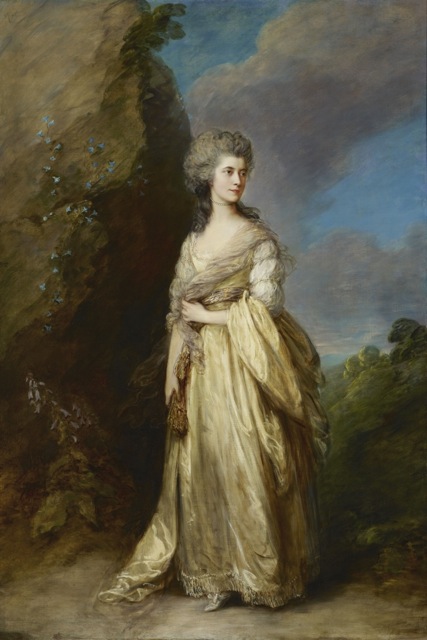
My favourite Gainsborough was of Frances Duncombe. Her expression seems the exact image of a newly married woman.
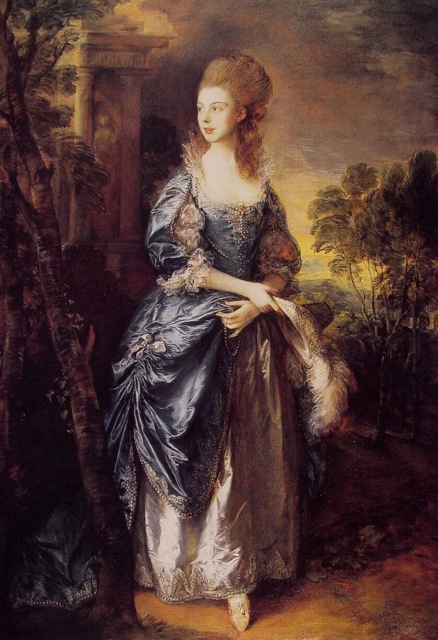
There was a terrible one of St James’s Park. The landscape was bad (as always), but the little people were indefinite and bad, too.
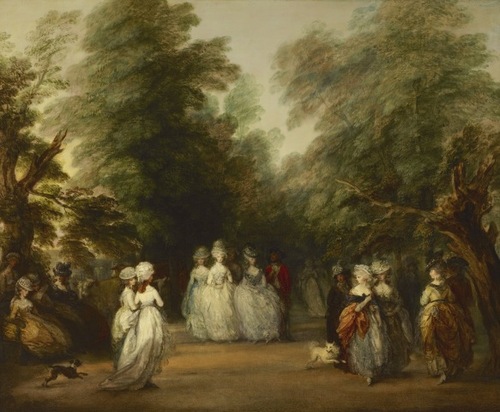
There are a number of Vermeers. This one left me rather cold, but for the iridescent window that the reproduction below completely fails to convey.
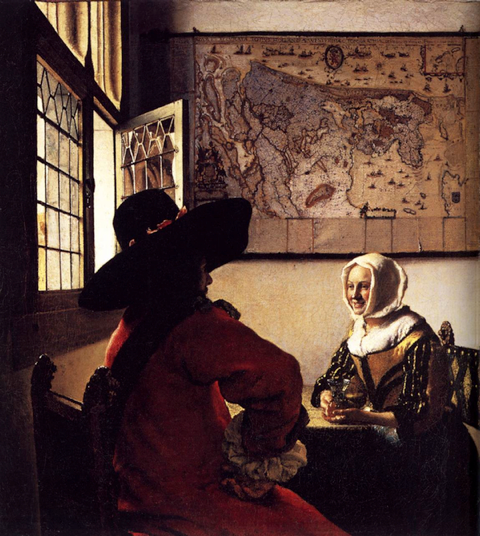
I much preferred this Vermeer, Mistress and Maid. I liked how the expressions of the mistress and maid matched so well that they looked like they were actually at a particular moment in their conversation, perhaps a discussion of some accounts. I liked the fineness of the painting of the mistress’s curls and the folds of her cloak.
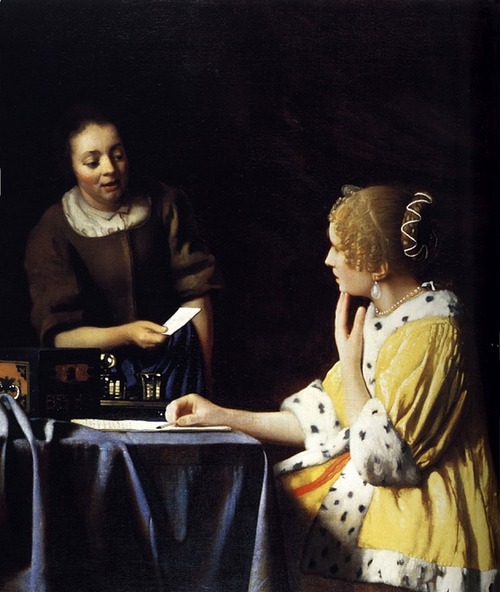
I discovered Ingres, who I had never heard of before. I was surprised to discover he lived in the nineteenth century. Comtesse d'Haussonville. Good chair with yellow drape. Good folds of dress. I liked how the Comtesse is being watched in the mirror. It’s a shame Ingres didn’t get the reflection quite right.
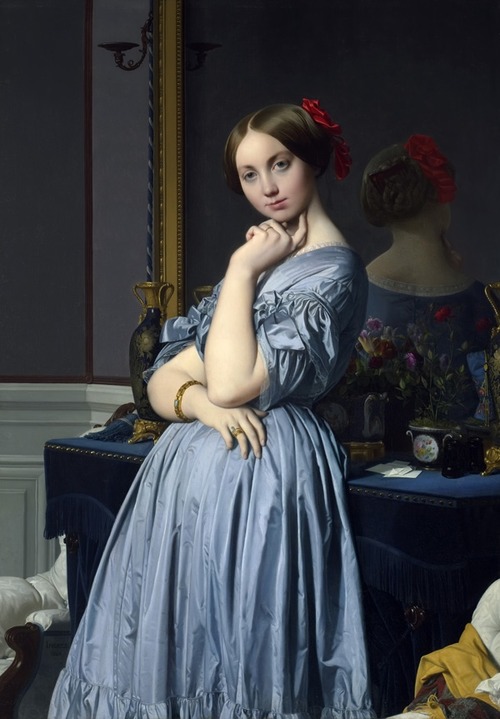
There was a good Veronese, the Choice of Hercules. A wonderfully classical face on the woman in green.

What was funny was that all these fantastic paintings lived in the same house as miles and miles of horrendous, drossy, sentimental frescoes. There were whole rooms of floor to ceiling wall paintings of young girls and boys with rosy cheeks leaping in gardens and handing each other roses.
Finally, there was Whistler, who has always left me rather cold. But, Symphony in Flesh Colour and Pink was oddly moving.
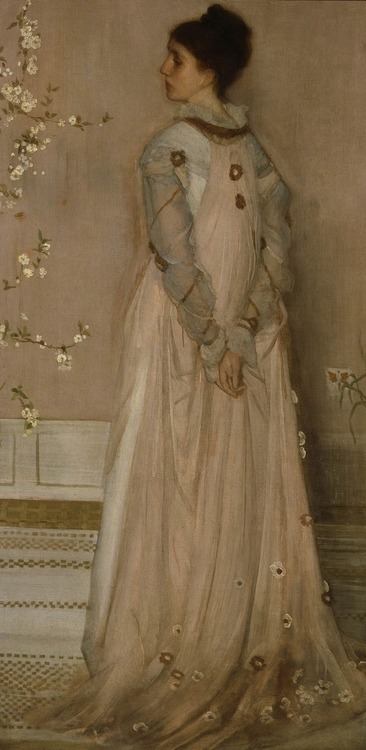
#notebook
The Frick
On Sunday, I went to the Frick, which knocked me sideways. It was like being in the Wallace, except even more intimate. Seeing those paintings in a (relatively) every day environment made them much more moving.
There was Adoration of the Magi by Bastini. Everyone looking at Jesus but bad-tempered Joseph, and Jesus looking at Mary. That wonderful circle of red from smock to armour to blouse to hat.

One of my faves was Lippi’s Annunciation. I like the fact that he decided to make both Mary and Gabriel deferential to each other. I like the great pillar between them. And I found it so interesting that, like so many medieval and early Renaissance paintings, the events take place in a weird, barren, classical room with a wall missing that reveals nothingness.

Mrs Baker.
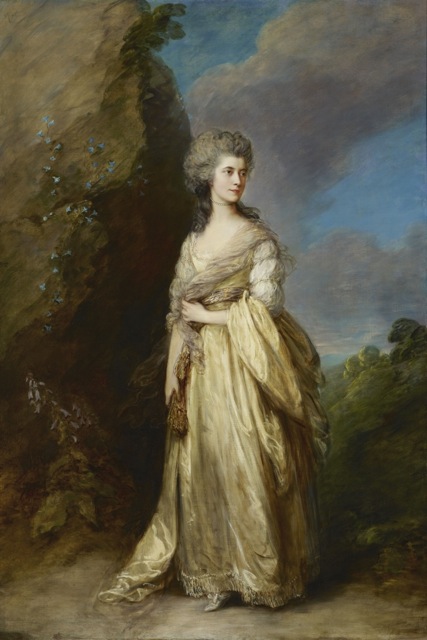
My favourite Gainsborough was of Frances Duncombe. Her expression seems the exact image of a newly married woman.
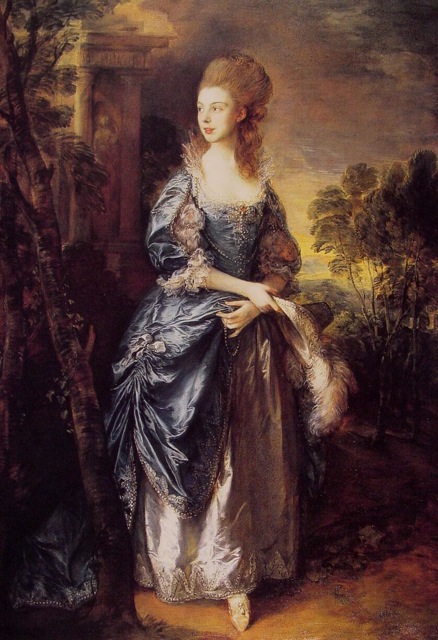
There was a terrible one of St James’s Park. The landscape was bad (as always), but the little people were indefinite and bad, too.
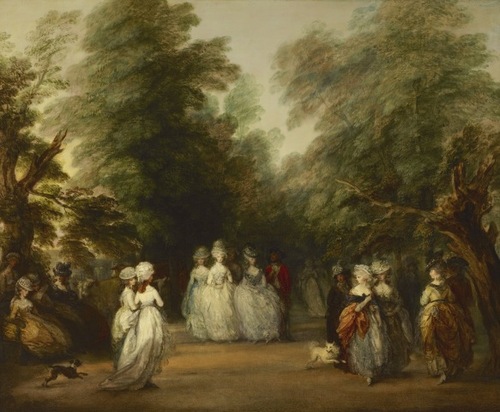
There are a number of Vermeers. This one left me rather cold, but for the iridescent window that the reproduction below completely fails to convey.
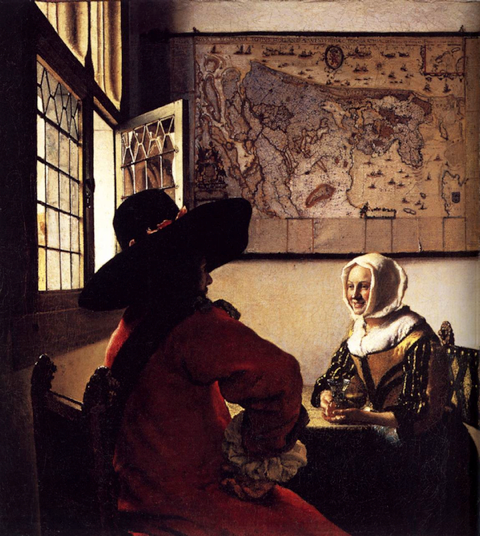
I much preferred this Vermeer, Mistress and Maid. I liked how the expressions of the mistress and maid matched so well that they looked like they were actually at a particular moment in their conversation, perhaps a discussion of some accounts. I liked the fineness of the painting of the mistress’s curls and the folds of her cloak.
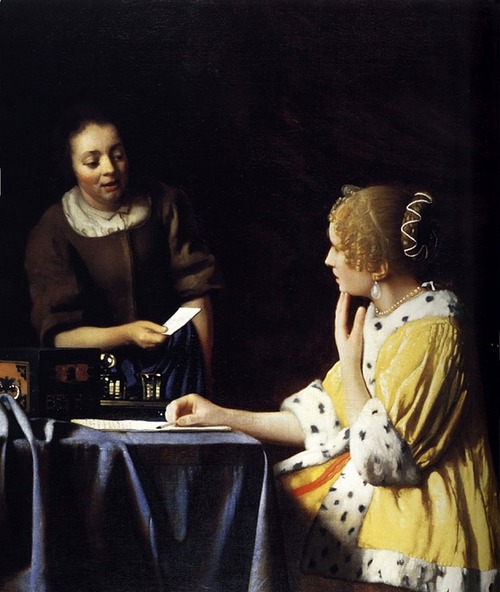
I discovered Ingres, who I had never heard of before. I was surprised to discover he lived in the nineteenth century. Comtesse d'Haussonville. Good chair with yellow drape. Good folds of dress. I liked how the Comtesse is being watched in the mirror. It’s a shame Ingres didn’t get the reflection quite right.
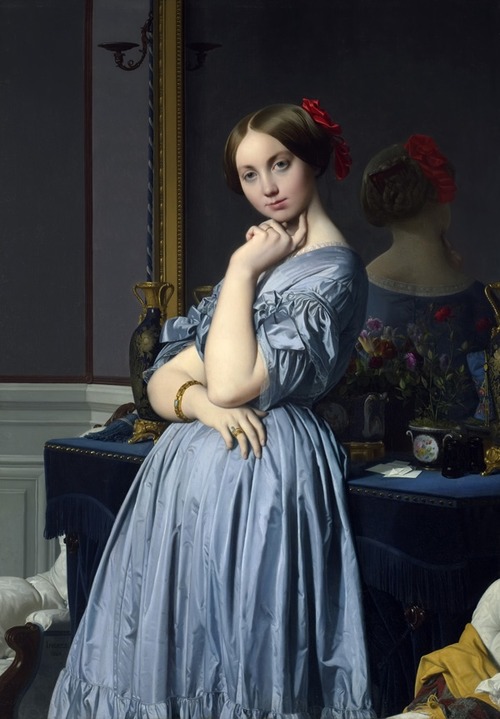
There was a good Veronese, the Choice of Hercules. A wonderfully classical face on the woman in green.

What was funny was that all these fantastic paintings lived in the same house as miles and miles of horrendous, drossy, sentimental frescoes. There were whole rooms of floor to ceiling wall paintings of young girls and boys with rosy cheeks leaping in gardens and handing each other roses.
Finally, there was Whistler, who has always left me rather cold. But, Symphony in Flesh Colour and Pink was oddly moving.
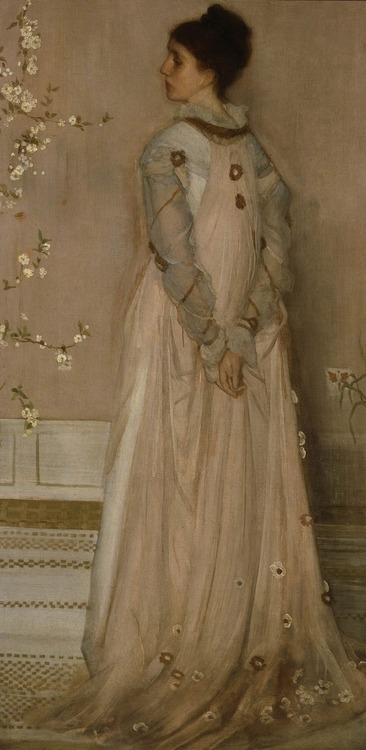
#notebook #medianotes
The Met
They had Canaletto’s painting of Piazza San Marco, which my mum would have liked, but which leaves me rather cold. All those precise people.
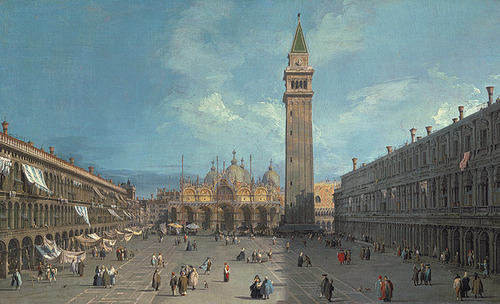
They had some Caravaggio.
A wonderful picture of a lute player whose sardonic, superior expression recalls ‘60s era Bob Dylan.
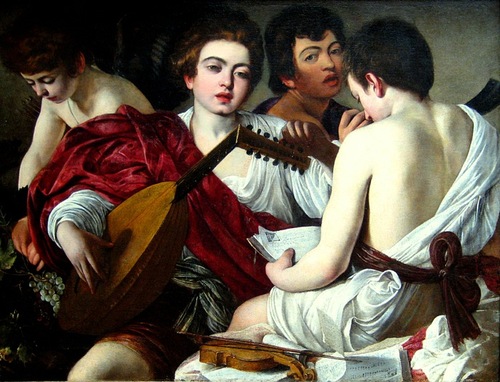
And The Denial of St Peter, with the woman being discreetly persuasive.
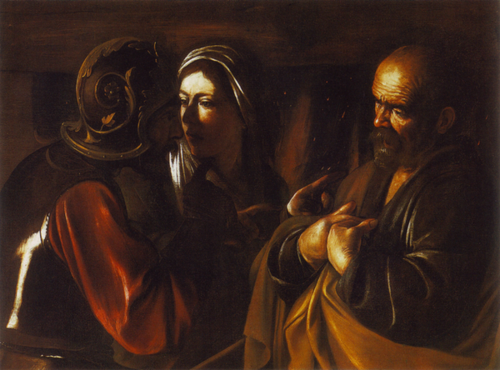
They had a whole room of Rembrandt. My favourite was Herman Doomer. The way his eyes crinkled at the corners. The way they shone with fluid and looked so human. The wispiness of his beard.
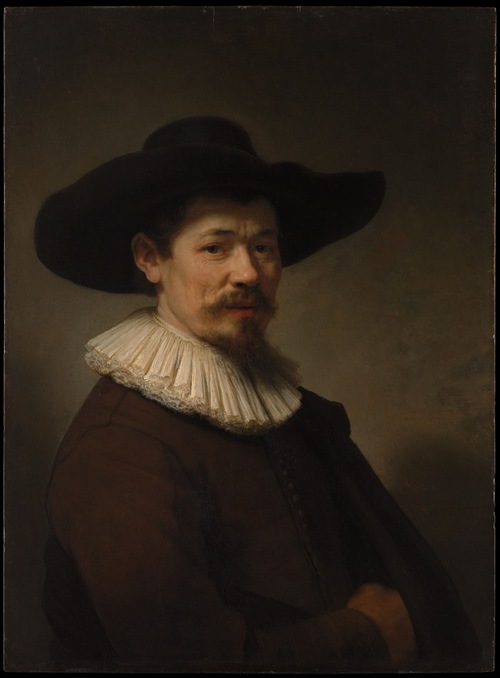
I found Danae by Gentileschi, who I had not heard of. A facsimile of an outstretched hand. A relentlessly well painted tucked in sheet.
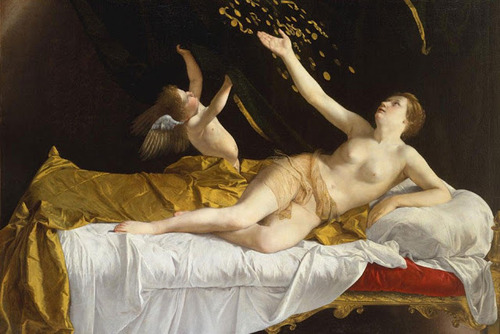
#notebook
The Met
They had Canaletto’s painting of Piazza San Marco, which my mum would have liked, but which leaves me rather cold. All those precise people.
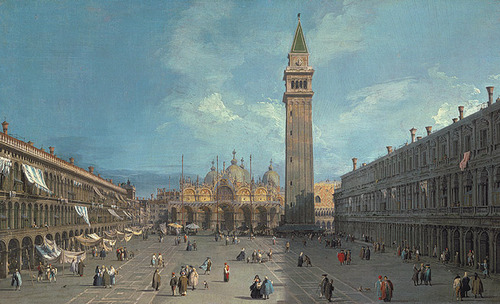
They had some Caravaggio.
A wonderful picture of a lute player whose sardonic, superior expression recalls ‘60s era Bob Dylan.
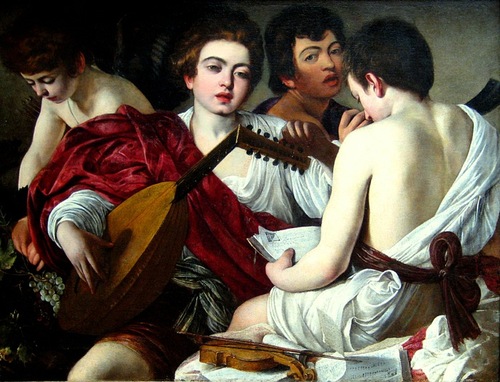
And The Denial of St Peter, with the woman being discreetly persuasive.
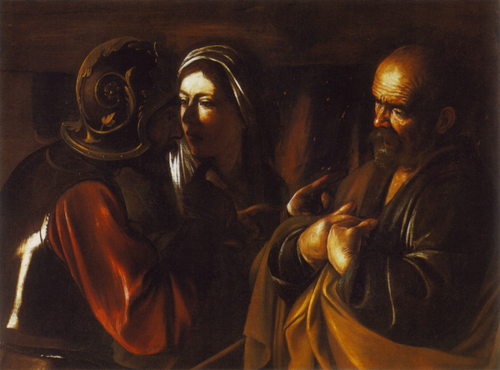
They had a whole room of Rembrandt. My favourite was Herman Doomer. The way his eyes crinkled at the corners. The way they shone with fluid and looked so human. The wispiness of his beard.
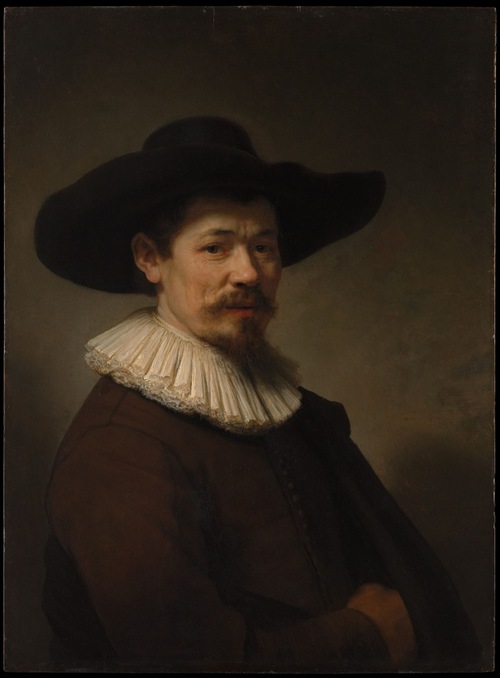
I found Danae by Gentileschi, who I had not heard of. A facsimile of an outstretched hand. A relentlessly well painted tucked in sheet.
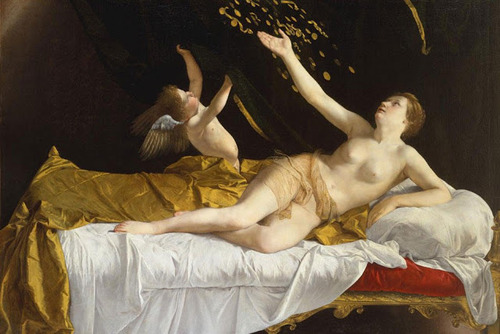
#notebook #medianotes
XXY
XXY
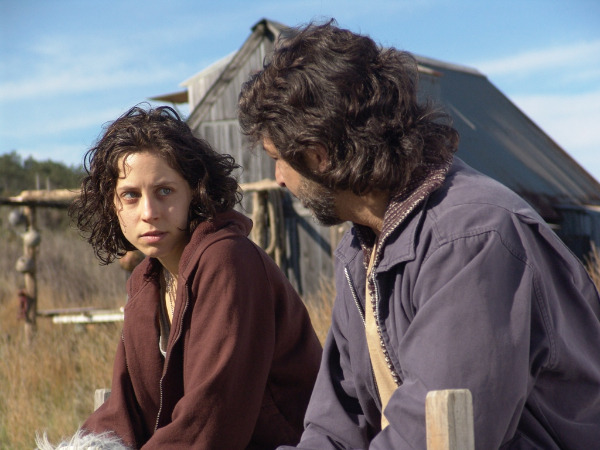
XXY
#notebook #medianotes






